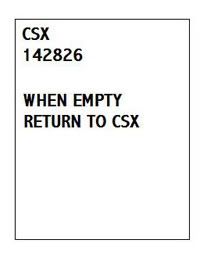As per request I am going to give a detailed account of a load traversing from point A to point B.
Ok,Let's follow CSX XM 142826 with a load of kitchen cabinets from Old South Cabinet Corp at Spartenburg SC to 86 Lumber Medina,Oh on the Huron River Ry.
After the car is loaded CSX will pick it up and forward the car to the HR at Barberton,Oh.After this car arrives on the HR our customer service representative will call 86 lumber and get delivery information.After the information is received the representative will forward the delivery information to the Barberton yard office..There the car will be added to the Huron Turn's switch list..The local will deliver the car.
Now 86 Lumber calls the customer service representative and reports CSX 142826 is empty..This information is past along to the Barberton yard office and added to the switch list as a empty pickup at 86 Lumber.The local will pick up the car and return it to Barberton where it will be turned over to the CSX on the next CSX transfer run.
Now IF the HR had a load going to a CSX customer then 142826 would have been loaded on the HR before being returned to CSX as per the per diem agreement.
Now understand IF HR held 142826 a Demurrage fee would be paid to CSX.So, in the above scenario we promptly returned the empty car to CSX to avoid having to pay the Demurrage fee.
Ok,Let's follow CSX XM 142826 with a load of kitchen cabinets from Old South Cabinet Corp at Spartenburg SC to 86 Lumber Medina,Oh on the Huron River Ry.
After the car is loaded CSX will pick it up and forward the car to the HR at Barberton,Oh.After this car arrives on the HR our customer service representative will call 86 lumber and get delivery information.After the information is received the representative will forward the delivery information to the Barberton yard office..There the car will be added to the Huron Turn's switch list..The local will deliver the car.
Now 86 Lumber calls the customer service representative and reports CSX 142826 is empty..This information is past along to the Barberton yard office and added to the switch list as a empty pickup at 86 Lumber.The local will pick up the car and return it to Barberton where it will be turned over to the CSX on the next CSX transfer run.
Now IF the HR had a load going to a CSX customer then 142826 would have been loaded on the HR before being returned to CSX as per the per diem agreement.
Now understand IF HR held 142826 a Demurrage fee would be paid to CSX.So, in the above scenario we promptly returned the empty car to CSX to avoid having to pay the Demurrage fee.



